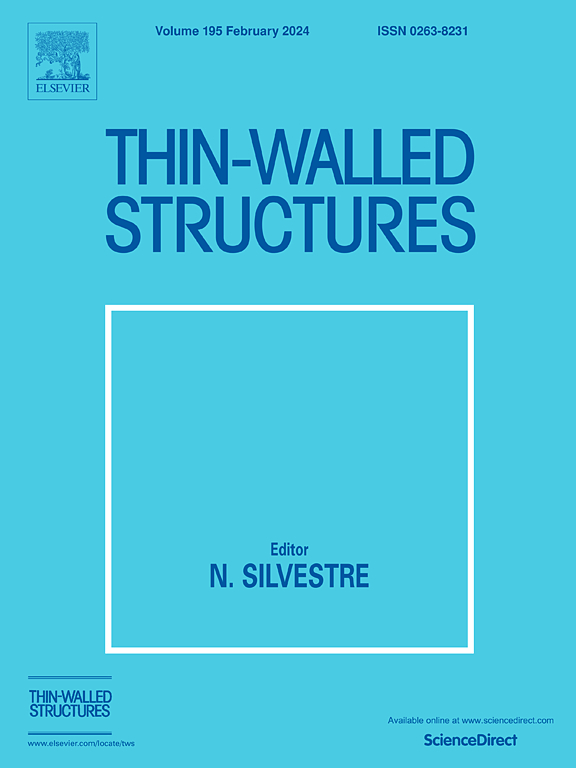High-velocity impact characteristics of 3D auxetic composite cylindrical shell panels: Theory and experiment
IF 5.7
1区 工程技术
Q1 ENGINEERING, CIVIL
引用次数: 0
Abstract
The high-velocity impact characteristics of 3D auxetic composite cylindrical shell panels are studied theoretically and experimentally. First, to predict the high-velocity impact parameters, including the residual velocity of the projectile, the energy absorption, and the ballistic limit, an analytical model of such structures consisting of two fiber/resin skins, two adhesive films, and a 3D auxetic lattice core is proposed, in which Reddy's higher-order shear deformation theory is employed to define the displacement variables. After taking into account the equivalent material properties of the core and various failure modes, energy absorption mechanisms, strain rate effect, and impact damage evolution issues of the constituent elements, governing equations and solutions are successfully obtained. To validate the model developed, detailed high-velocity impact tests with different initial velocities are then performed on such shell panel specimens with nylon and metal auxetic lattice cores fabricated by 3D printing technology. Finally, the influences of key geometric parameters of the core on impact properties are investigated, with some important design recommendations being refined to improve the impact resistance and energy absorption capabilities of the studied structure.
三维复合材料圆柱壳板的高速冲击特性:理论与实验
对三维复合材料圆柱壳板的高速冲击特性进行了理论和实验研究。首先,为了预测弹丸的剩余速度、能量吸收和弹道极限等高速冲击参数,提出了由两层纤维/树脂皮、两层胶膜和三维形变晶格核组成的高速冲击结构的解析模型,其中采用Reddy的高阶剪切变形理论定义位移变量。在考虑了芯材的等效材料特性和各失效模式、能量吸收机制、应变率效应、冲击损伤演化等问题后,成功地得到了控制方程和解。为了验证所开发的模型,然后在使用3D打印技术制造的尼龙和金属辅助晶格芯的壳板样品上进行了不同初始速度的详细高速冲击试验。最后,研究了核心关键几何参数对冲击性能的影响,并提出了一些重要的设计建议,以提高所研究结构的抗冲击和吸能能力。
本文章由计算机程序翻译,如有差异,请以英文原文为准。
求助全文
约1分钟内获得全文
求助全文
来源期刊

Thin-Walled Structures
工程技术-工程:土木
CiteScore
9.60
自引率
20.30%
发文量
801
审稿时长
66 days
期刊介绍:
Thin-walled structures comprises an important and growing proportion of engineering construction with areas of application becoming increasingly diverse, ranging from aircraft, bridges, ships and oil rigs to storage vessels, industrial buildings and warehouses.
Many factors, including cost and weight economy, new materials and processes and the growth of powerful methods of analysis have contributed to this growth, and led to the need for a journal which concentrates specifically on structures in which problems arise due to the thinness of the walls. This field includes cold– formed sections, plate and shell structures, reinforced plastics structures and aluminium structures, and is of importance in many branches of engineering.
The primary criterion for consideration of papers in Thin–Walled Structures is that they must be concerned with thin–walled structures or the basic problems inherent in thin–walled structures. Provided this criterion is satisfied no restriction is placed on the type of construction, material or field of application. Papers on theory, experiment, design, etc., are published and it is expected that many papers will contain aspects of all three.
 求助内容:
求助内容: 应助结果提醒方式:
应助结果提醒方式:


